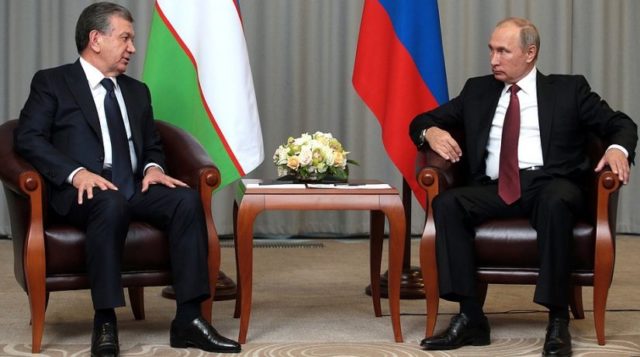
Moscow’s Approach to Central Asia Fails to Reflect New Realities, Uzbek Scholar Says
Publication: Eurasia Daily Monitor Volume: 17 Issue: 96
By:

Analysts and policymakers dealing with the post-Soviet space frequently rely on frameworks that might have been appropriate a generation ago but no longer correspond to today’s realities. Nowhere is that truer than in the way outsiders, including Russians, view and interact with Central Asian countries. Already, half of their populations were born since the Soviet Union disintegrated. Moreover, Central Asians are more informed by recent changes within and adjoining the region than by sometimes Orientalist imagery about silk roads and social and political events of hundreds or even thousands of years ago.
That is not to say that these earlier historical legacies or images have no utility. They do reflect important geographic and cultural continuities. But those who invoke them must not be blind to their limitations or ignore more recent developments. The peoples in the region can see this; and now, some local commentators are predictably lashing out at what they consider outdated imperial ideas and pretensions Moscow has toward Central Asia—a region that, today, consists of five independent countries, increasingly different from their common Soviet past and from one another.
In last Sunday’s (June 28) NG-Dipkuryer, Farkhod Tolipov, the director of the independent “Caravan of Knowledge” center in Tashkent, takes aim at the ways Moscow’s “outdated” notions of his country and the Central Asian region “do not correspond to today’s realities” and are skewing Russian policies (NG-Dipkuryer, June 28). Not surprisingly, his sharp words have provoked an equally harsh reaction from at least one Moscow-based analyst (IA-Center, July 2).
Tolipov, one of the most prominent independent foreign policy analysts in Uzbekistan, studied at the NATO Defense College, Harvard University and the University of Georgia. He has thus had a greater opportunity than many others in Central Asia to compare the paradigms Russian analysts and policymakers apply to his region with those used by their counterparts in the West. He begins his new essay with the observation that “it would seem” that “nowhere in the world do people know Central Asia as well as they do in Russia,” given that country’s involvement there over the last two centuries and especially the inclusion of the region into the Soviet Union. And yet, since 1991, Tolipov says, “Russian experts and politicians alike have demonstrated a poor and superficial knowledge of the countries of Central Asia or have intentionally distorted the essential features of [local] events and processes.” People in Moscow have continued to rely on increasingly inappropriate ideas and imagery, a trend that both reflects and has contributed to Moscow’s “neo-imperial” approach (NG-Dipkuryer, June 28). Why has this happened? he asks. What do Russians really think about Central Asia? And why have they been so often wrong over the last three decades?
The answers are obvious, Topilin argues. Russia has acted in ways that require such an image of the region because it has assumed Central Asia must be part of the Russian sphere of influence rather than a region open to all. But those who engage in such discussions ignore the real facts on the ground—something that is always a mistake, he posits. “The rhetoric of spheres of influence in particular is characteristic of great powers but not small countries,” the Tashkent analyst continues. “We do not speak about the spheres of influence of Uzbekistan, Kazakhstan or Kyrgyzstan,” although one could. Instead, great powers rarely take the interests and influence of the small countries into account, and they view them as pawns that the powers can push around without regard to what the smaller countries want.
Zbigniew Brzeziński famously observed, Topilin points out, that “America is too far away to be dominant in this part of Eurasia but too powerful not to be involved,” while “Russia is too weak to restore its imperial dominance over the region or to exclude the dominance of other powers, but it is too close and strong to be excluded.” Russian analysts have failed to take that into account, Topilin asserts, preferring instead to rely on “survivals of the Soviet or imperial past.”
According to the Tashkent-based expert, Moscow insists that the only regional integration permissible in Central Asia is one led by Russia. It argues that the region is a breeding ground or at least a transit zone for Islamist extremism, with which these countries cannot cope on their own (see EDM, May 29). And finally, Tolipov says, in contrast to the North Atlantic Treaty Organization (NATO) and the United States, Russia so devalues what Central Asia represents that Russian analysts and policymakers see no need to update their conceptions. Instead, Moscow’s experts seem content to remain in an intellectual “comfort zone” increasingly at odds with reality. Central Asian countries can and do cooperate with each other (see EDM, March 20, 2018). They have shown themselves capable of combatting Islamist terrorism on their own. And they believe they are important enough that any power wanting to develop relations with them should have a well-thought-out policy rather than relying on the myths of the past.
Russian commentators balk at such arguments. But one of the first serious reactions to Topilin’s article has had the unintended effect of reinforcing his points: In an essay for Moscow’s IA-Center portal, Andrey Karpov does not directly dispute what the Uzbekistani writer has said but notes that Moscow has many prominent specialists on the region as well as numerous research centers devoted to Central Asia (IA-Center, July 2). Because there are so many, he contends, Russian analysts must certainly understand the region.
And yet, though sheer numbers may look impressive, they do not speak to who is right and who is wrong. And importantly, when analysts challenge the lenses through which others view the situation, they inherently lay the groundwork for challenging the very policies that stem from them as well.



